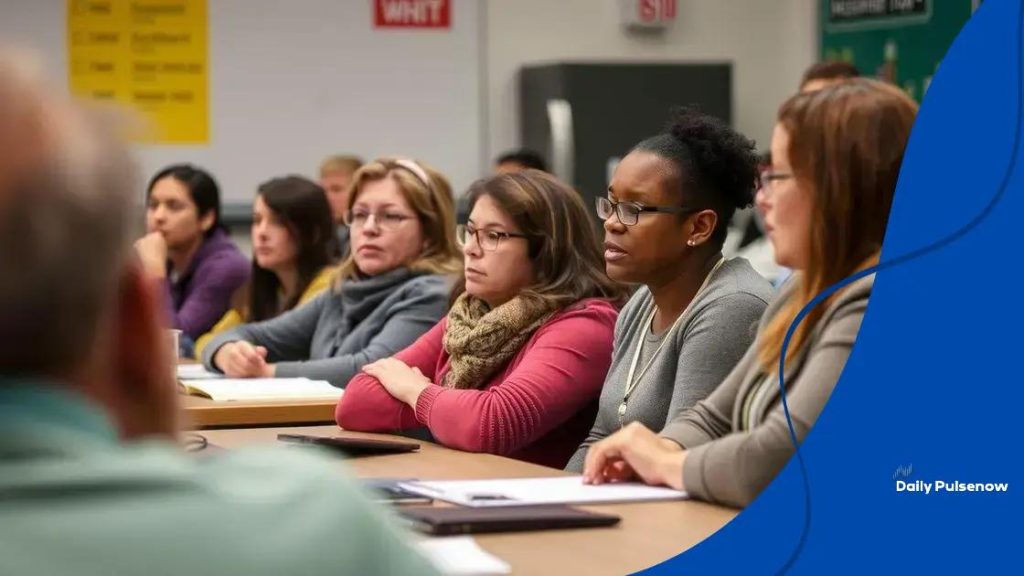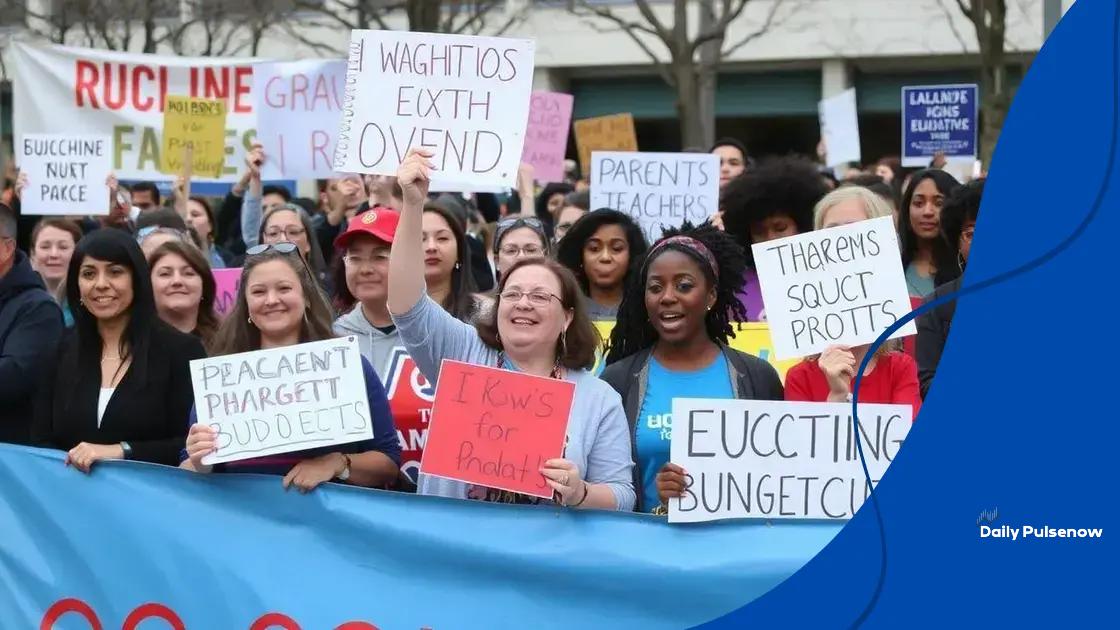Education budget cuts proposal: what you need to know

Anúncios
The education budget cuts proposal highlights significant risks to student learning, including reduced resources, larger class sizes, and cuts to essential programs, prompting communities to advocate for funding and explore creative solutions.
Education budget cuts proposal can be a scary topic for many. Have you considered how these cuts might affect the quality of education for our children? In this article, we’re going to unpack the implications of these proposals and the wider effects on schools and communities.
Anúncios
Understanding the causes of education budget cuts
Understanding the causes of education budget cuts is essential to grasp how these decisions impact learning environments. There are several factors that can lead to budget constraints in education systems.
Economic Challenges
Economic downturns often force governments to reevaluate funding. When tax revenue decreases due to recession, education budgets typically face cuts. Schools have to make tough choices about which programs to maintain.
Policy Decisions
Another significant factor is policy changes at the local, state, or federal level. New legislation can prioritize certain sectors over education, redirecting necessary funds elsewhere. For example, when funding is allocated for infrastructure or public safety, education may suffer.
Anúncios
Demographic Changes
Shifts in population can also influence funding. Areas with declining student enrollment may see reductions in education budgets. As such, maintaining quality education in shrinking districts can be challenging.
- Economic recessions leading to lower tax revenues
- Policy shifts favoring other areas over education
- Demographics impacting school funding based on enrollment
- Increasing costs without proportional funding increases
These aspects are critical to consider when examining the education budget cuts proposal. When schools lack sufficient resources, it affects the overall quality of education. As budget constraints tighten, educators and policymakers must navigate these challenging realities.
Impacts of budget cuts on student learning
The impacts of budget cuts on student learning can be far-reaching and detrimental. Students may face reduced access to essential resources that enhance their educational experience. These cuts often lead to fewer teachers, larger class sizes, and diminished programs.
Reduced Course Offerings
One immediate effect of budget cuts is the reduction in course offerings. Schools may have to eliminate subjects such as art, music, or foreign languages. This limits students’ exposure to diverse learning opportunities.
Larger Class Sizes
Another consequence is the increase in class sizes. With fewer teachers available, classrooms can become overcrowded. This makes it challenging for educators to provide individualized attention to each student, thereby affecting their learning outcomes.
- Less personalized attention for students
- Increased stress on teachers to manage larger groups
- Strain on classroom dynamics and interactions
- Potential decrease in student engagement
Additionally, essential support services such as counseling and special education can face cuts. These programs are crucial for helping students who might struggle academically or emotionally. When these supports are weakened, the overall learning environment suffers. School morale can decrease as well, leading to reduced motivation and achievement among students.
In summary, the effects of budget cuts are serious. Schools must find a way to balance their financial constraints while still supporting students effectively. By understanding these impacts, communities can better advocate for necessary resources and changes.
Strategies for advocating against budget cuts

Advocating against budget cuts in education requires a strategic approach. Communities and stakeholders must come together to make their voices heard. There are various ways to effectively advocate for better funding and resources.
Building a Coalition
One of the most effective strategies is forming a coalition of parents, teachers, and community members. By collaborating, these groups can amplify their voices. A united front can make a significant impact when addressing school boards and local governments.
Raising Awareness
Raising awareness in the community is crucial. Use social media or local news outlets to highlight the consequences of funding cuts. Share personal stories from students and educators to illustrate the real-life impact of these decisions.
- Organize community forums to discuss the issues
- Engage local media with press releases and stories
- Utilize social media campaigns to spread the message
- Encourage supportive community members to share their experiences
Another important tactic is to reach out to local policymakers. Schedule meetings with elected officials to express concerns. Present facts and data to support claims about how cuts are hurting students. Politicians need to hear personal testimonies to understand the emotional aspect behind the numbers.
In addition, consider organizing rallies or events to draw public attention. These events can serve as platforms to educate others about the importance of adequate funding in education. Events that engage the community can build momentum and support for the cause.
Alternatives to mitigate the effects of cuts
Finding alternatives to mitigate the effects of budget cuts in education is critical. Schools can explore various options to ensure that students continue to receive quality learning experiences despite financial limitations.
Enhanced Community Partnerships
One effective strategy is to strengthen partnerships with local businesses and organizations. These collaborations can provide valuable resources and support. Businesses may offer internships, funding, or supplies that can help fill the gaps left by budget cuts.
Utilizing Grants and Funding Opportunities
Schools can actively seek grants and additional funding sources. Many nonprofit organizations and government programs offer grants specifically aimed at assisting schools in financial distress. By researching and applying for these funds, schools can secure additional resources.
- Local foundations often support educational initiatives
- Federal and state grants can be applied for specific programs
- Partnering with universities may open new funding avenues
- Community fundraising events can raise awareness and money
Additionally, schools should prioritize resource sharing and collaboration among districts. By pooling resources and sharing best practices, school districts can reduce costs while maximizing their offerings. Collaborating allows schools to combine forces on staff training, special programs, and even shared technology expenses.
Another alternative is to implement cost-saving measures. This includes examining and streamlining operational expenses. Schools can look at transportation costs, utility savings, and supply purchasing to find ways to cut spending without impacting students directly. Some districts have had success in negotiating better deals with vendors or adopting more energy-efficient practices.
Looking at successful funding proposals
Looking at successful funding proposals can provide valuable insights for schools facing budget cuts. These proposals often highlight creative solutions and methods to secure support for essential programs.
Identifying Effective Strategies
Successful proposals often focus on clear, specific goals. This clarity helps reviewers understand the purpose and impact of the funding request. For example, a proposal might aim to increase after-school programs or enhance technology in classrooms. Including measurable outcomes is also crucial, as it demonstrates accountability and the potential for positive results.
Collaborative Efforts
Many effective proposals involve collaboration with community partners. Schools can illustrate how they will work with local businesses or nonprofits to maximize resources. These partnerships can help increase the proposal’s credibility and broaden its support base.
- Highlight collaborative projects to show community investment
- Include letters of support from local organizations
- Demonstrate past successful collaborations
- Outline shared goals with community partners
Another important aspect is crafting a compelling narrative. Storytelling can engage reviewers emotionally, making the need for funding more relatable. Successful proposals often include anecdotes from students and teachers that showcase the direct impact of funding on education quality.
Additionally, transparency in budgeting is essential. Proposals should include a detailed budget that explains how funds will be allocated. Clear breakdowns help build trust with funders and show that the request is thoughtful and well-planned.
FAQ – Frequently Asked Questions about Education Budget Cuts and Advocacy
What are the main impacts of budget cuts on education?
Budget cuts can lead to larger class sizes, reduced course offerings, and diminished access to essential resources for students.
How can communities advocate against education budget cuts?
Communities can advocate by forming coalitions, raising awareness through social media, and engaging local policymakers with personal stories.
What are some successful strategies for funding proposals?
Successful proposals often include clear goals, collaborative partnerships, and compelling narratives that highlight the need for funding.
How can schools mitigate the effects of budget cuts?
Schools can mitigate effects by enhancing community partnerships, applying for grants, sharing resources among districts, and implementing cost-saving measures.